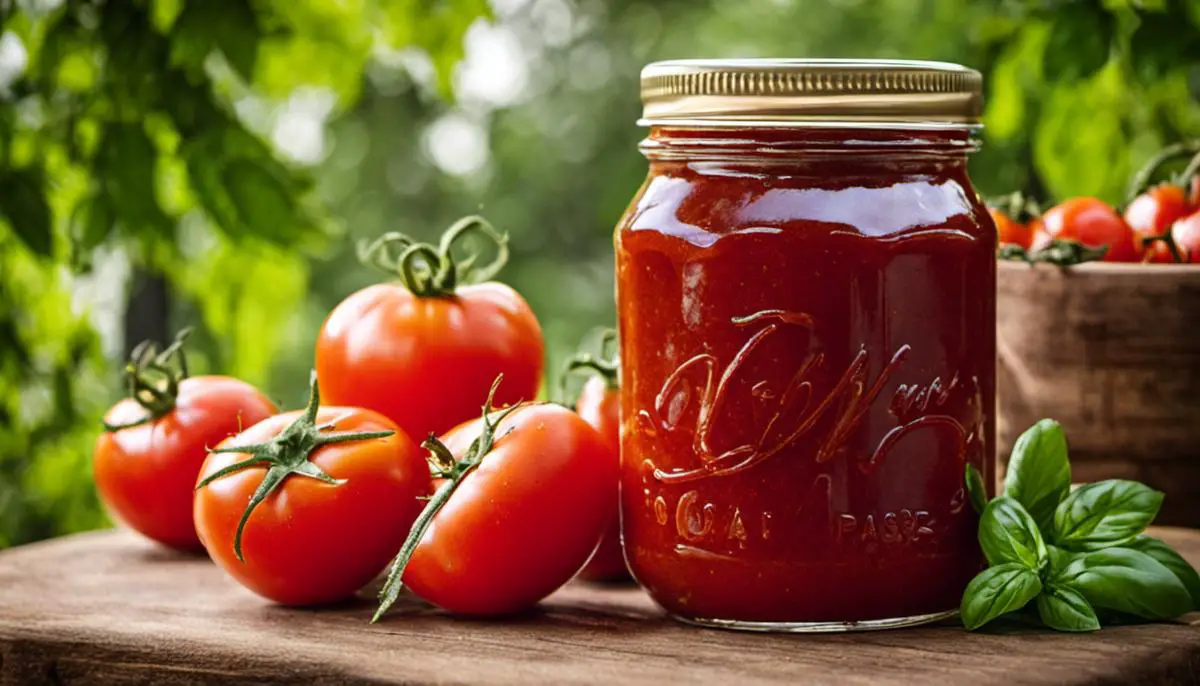Table of Contents
Delving into the world of homemade tomato paste can be a rewarding venture, not only by enhancing the flavors in your cookery but also by equipping you with a skill that contributes to a healthier and more sustainable lifestyle. Tomato paste, a staple of many traditional recipes, serves as a flavor backbone in a variety of dishes, and understanding how to make it from scratch can significantly elevate your culinary game. Our journey begins by highlighting the critical role of selecting and preparing the perfect tomatoes, as the quality directly influences the final product. Subsequently, we will explore the processes of cooking and straining the tomatoes to produce a rich pulp and cook it down into a dense, savory paste. Finally, we will unlock the secrets of packing and storing your homemade tomato paste to ensure a long shelf life and the best quality when you use it.
Selecting and Preparing the Tomatoes
Selecting the Perfect Tomatoes
Choosing the perfect tomatoes forms the basis for an outstanding tomato paste; the taste, color, and consistency of your paste will directly depend on the quality of your tomatoes. Thus, it’s essential to opt for high-quality, ripe, and flavorful tomatoes. While any variety will do, Roma tomatoes are often the best for tomato pastes due to their low moisture content and marvelous flavor.
When at the market or grocery store, select tomatoes that are vibrant in color and firm to the touch. They should not have any cracks, bruises, or spots. Moreover, the tomatoes should smell sweet and earthy – this is a reliable indicator of a ripe and flavorful tomato.
Preparing the Tomatoes
Once you have your perfect tomatoes, it’s time to start preparing them. Begin by thoroughly washing your tomatoes under running water to remove any dirt and pesticides. If desired, you may scrub them gently with a vegetable brush.
After washing, proceed to core the tomatoes. Coring involves removing the tough inner part of the tomato where the stem was attached. This can be done using a small, sharp knife. Hold the tomato firmly and cut a shallow circular incision around the stem end. Then, angle the knife and cut into the tomato to remove the core. Be sure to discard any green parts as they can make the paste bitter.
Once cored, you can proceed to chop the tomatoes. The optimal size of the pieces will depend on how chunky or smooth you prefer your paste. For a smoother paste, consider cutting your tomatoes into smaller pieces, while for a chunkier paste, larger pieces may be more desirable. However, it’s important to note that regardless of the size, the pieces of tomatoes must be uniform to ensure even cooking.
Perfect selection and preparation of your tomatoes are the first critical steps towards creating an alluring homemade tomato paste. By following these guidelines, you’re on your way to a flavorful and impressive paste that will surely enhance all your culinary endeavors.

Cooking and Straining the Tomatoes
Preparation of Tomatoes
Start by choosing ripe, fresh tomatoes for your homemade tomato paste. The red and plump ones are the ideal kind, as they are packed with the sweet and savory flavors that will make your tomato paste rich and satisfying. Gather about 5 pounds of these quality tomatoes. Rinsing them in fresh water to remove any dirt or residue. Once they are clean, use a sharp knife to coarsely chop the tomatoes, ensuring that both the juicy flesh and the flavorful interior are included.
Cooking the Tomatoes
To prepare the tomato mixture, start by placing the chopped tomatoes into a large, deep pot. You don’t need to add any water, as the tomatoes will release their juices as they cook. Set the heat to medium, and allow the tomatoes to simmer. Stir occasionally to prevent burning or sticking, and make sure that the tomatoes are breaking down properly.
Cook the tomato mixture for about 1 hour until it forms a thick, pulpy texture. This stage is important because longer cooking time ensures the intense flavor that characterizes good tomato paste. Taste occasionally to see if the mixture is sweet and robust enough. If it’s bland, you might want to add a pinch of salt and sugar to taste.
Straining the Tomatoes
Once the tomatoes are cooked down to the right consistency, the next step is to strain them. This is done to remove the seeds and skins that won’t blend into the tomato paste and can affect the texture and taste of the final product.
Use a fine mesh strainer or food mill for the task. Pour the tomato pulp into the strainer, which should be set over another pot or large bowl. Use the back of a spoon or spatula to press down on the mixture, forcing the liquid and fine pulp through the strainer while leaving the seeds and skins behind.
Take your time with this step, and make sure to extract as much liquid and pulp as possible to maximize the yield of your homemade paste. Once you are done straining, the material left in the strainer can be discarded.
You should now be left with the rich, smooth tomato pulp. This is the base for your homemade tomato paste. The following steps will involve further cooking and concentrating this pulp until it reaches the consistency and flavor of tomato paste. Remember, making tomato paste at home may require some time and effort, but the resulting product, packed with flavor and devoid of preservatives, is worth it.

Cooking the Tomato Pulp
Gathering Ingredients and Preparations
To begin with, collect all the required ingredients. You will need ripe tomatoes, salt, and a bit of olive oil. All tomatoes are fine, but plum tomatoes with less moisture content can save you some cooking time. It’s a good practice to wash the tomatoes and then cut them into quarters.
Initial Cooking
Place all the quartered tomatoes in a large pot. Put the pot over medium-high heat and bring the tomatoes to boil. You may add a pinch of salt to taste at this point. Once boiling, reduce the heat to medium-low and allow the tomatoes to simmer. Your focus should be on turning the tomatoes into a pulp, which usually takes about an hour.
Removing Skins and Seeds
After the tomatoes have broken down into a pulp, let the mixture cool. Once cooled, you’ll need to remove the skins and seeds. You can achieve this by pressing the pulp through a fine-mesh sieve or food mill. The concentration is primarily in the pulp, so ensure to extract as much juice as possible. Discard the remaining skins and seeds.
Cooking Down the Pulp
Return the sieved pulp back to the pot and once again set it on medium heat. At this point, be ready to invest some patience, as this is the slow cooking phase. You will be cooking the tomato pulp down into a concentrated paste. This process may need occasional stirring to prevent the pulp from sticking to the bottom.
Achieving the Right Texture
Keep the heat at a consistent medium-low to reduce the likelihood of the paste scorching. The aim is to evaporate nearly all of the water content. The paste should become quite thick and should hold its shape when stirred. This process can take between 2 to 3 hours but is crucial for achieving the correct texture for your tomato paste.
Adding Flavor
One key trick to achieving the deeper flavor associated with tomato paste is the addition of a bit of olive oil during the last stages of cooking. Add a few tablespoons of olive oil, stir it in, and allow the paste to cook for an additional few minutes. This will give your homemade tomato paste a rich, robust flavor that surpasses any store-bought version.
Storing the Tomato Paste
Once you’re satisfied with the consistency and flavor of the paste, remove from heat and let it cool. You can store this paste in an airtight container in the refrigerator. It will keep fresh for up to a week. For longer storage, portion the paste into an ice cube tray and freeze. Once frozen, you can transfer the cubes to a freezer bag and just thaw a cube whenever you need tomato paste.

Packing and Storing Tomato Paste
Preparing Jars for Tomato Paste
The first step to storing homemade tomato paste is to prepare your glass jars. Start by thoroughly washing the jars in hot, soapy water. Rinse them thoroughly to ensure all soap residue is removed. After washing the jars, you need to sterilize them. This step is crucial to remove all bacteria and germs that could contaminate your tomato paste. The easiest way to sterilize is by placing the jars in a large pot of boiling water for about 15 minutes. After sterilizing, remove the jars carefully with a jar lifter or tongs, and set them on a clean towel to dry.
Packing Tomato Paste into Jars
Once your jars are clean and dry, it is time to pack the tomato paste. It is important to pack the paste while it’s still hot to ensure proper preservation. Use a spoon or a ladle to carefully fill the jars, leave at least 1/2 inch of space at the top to allow for expansion. After filling the jars, wipe the rims with a clean, damp cloth to remove any tomato paste that may have spilled over. This step is crucial as any residue could prevent the jars from sealing correctly.
Sealing and Cooling the Jars
After packing the tomato paste, it’s time to seal the jars. Place sterilized lids on top of the jars and then screw on the bands until they are finger tight. Once the jars are sealed, let them cool at room temperature for about 12 to 24 hours. Ensure the jars are kept in a cool, dry place out of direct sunlight during this time.
Freezing Tomato Paste
If you prefer to freeze your tomato paste, begin by letting the paste cool completely. Then, spoon it into ice cube trays or small plastic containers with airtight lids. Remember to leave a little space at the top of each container for expansion during freezing. Once the containers are sealed, label them with the date and place them in the freezer.
Storing Tomato Paste
For maximum shelf life and quality, store sealed jars of tomato paste in a cool, dark place such as a pantry or cellar. The colder the storage temperature within this range, the longer the paste will keep. If you chose to freeze your tomato paste, it can be stored in the freezer for up to six months. To use frozen tomato paste, simply remove the amount you need and thaw it in the refrigerator or microwave.
Remember, always check stored jars and containers of tomato paste for signs of spoilage, like a foul odor or mold, before using. If in doubt, it’s safer to throw it out.

Overall, becoming adept at making homemade tomato paste not only adds an ace in your culinary sleeve but also allows a deeper connection with the food you craft and consume. Whether it’s using the paste to enrich a simmering bolognese, adding depth to a homemade pizza sauce, or simply spreading it on a toast slice topped with fresh mozzarella and basil, the advantages of homemade tomato paste are countless. Remember, the selection of tomatoes is a paramount task, while the correct cooking and straining process ensures the right taste and texture in the paste. Proper packing and preserving techniques can keep your flavorful paste in prime condition. Here’s to healthier, tastier, and more conscious cooking experiences with your homemade tomato paste.
